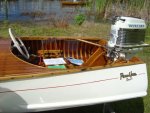mlbinseattle
Petty Officer 2nd Class
- Joined
- Aug 1, 2015
- Messages
- 100
I'm starting a new thread about this. There's another thread, but it's quite long and I'm now looking for input regarding various areas.
I've attached a couple of pics. One is the lower unit base (exhaust extension) and the other is the lower block area (lower crank seal, water input and exhaust output).
Notice the milky oil in the driveshaft area where it sticks out? Where do you suppose that's coming from? Lower unit seal below the water pump, or bad base gasket allowing water from the water input into the driveshaft area in addition to a leaky lower crank seal?
Any input regarding the lower block base area?
I'm in the process of drilling/tapping the last hole for the cylinder head cover (water jacket cover?), then I'm going to remove the exhaust plate/divider plate to inspect that area. I'll post more pics once I'm done with all that.
As always, your input is appreciated.
@emckelvy
@chris1956
bill kubiak
I've attached a couple of pics. One is the lower unit base (exhaust extension) and the other is the lower block area (lower crank seal, water input and exhaust output).
Notice the milky oil in the driveshaft area where it sticks out? Where do you suppose that's coming from? Lower unit seal below the water pump, or bad base gasket allowing water from the water input into the driveshaft area in addition to a leaky lower crank seal?
Any input regarding the lower block base area?
I'm in the process of drilling/tapping the last hole for the cylinder head cover (water jacket cover?), then I'm going to remove the exhaust plate/divider plate to inspect that area. I'll post more pics once I'm done with all that.
As always, your input is appreciated.
@emckelvy
@chris1956
bill kubiak






















